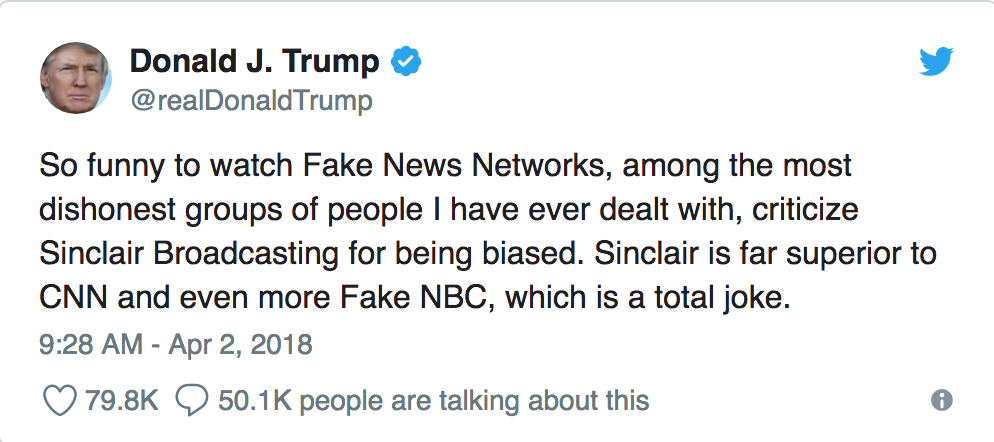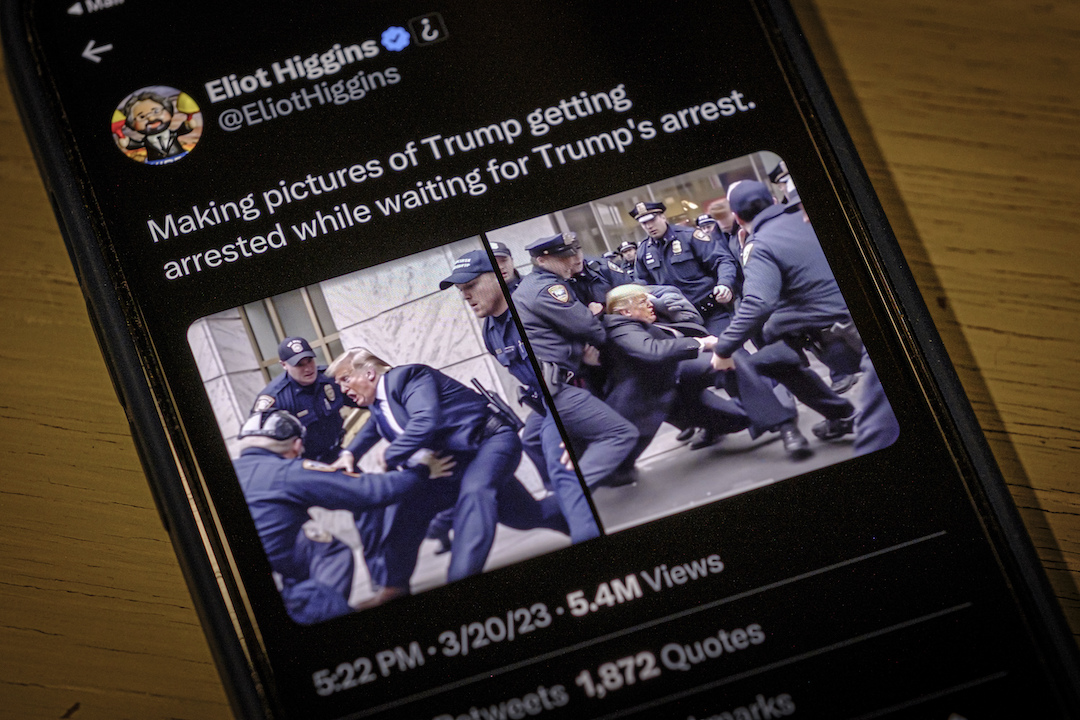Three of Sinclair Broadcast Group's top news executives are former National Press Photographers Association award winners. So when NPPA issued a statement Wednesday criticizing Sinclair for requiring local news anchors to read the same corporately written statement on-air condemning "fake news" it was a stinging critique.
Less than 24 hours later, NPPA said Sinclair withdrew a promised $25,000 donation to the NPPA legal fund.
NPPA joined a chorus of critics, including the Society of Professional Journalists and the National Association of Black Journalists, who raised concerns about Sinclair's "news promotion."
Sinclair Vice President Scott Livingston told Poynter that the statement was the product of a national survey of 2,200 news viewers. The survey asked what hot topics viewers were concerned about and, Livingston said, one key issue that emerged was the viewer concerns about "fake news."
The survey, Livingston said, asked the viewers if they would consider it to be politically biased if local anchors read a statement that condemned fake news and invited viewers to hold the station accountable if they saw such content on Sinclair newscasts. Livingston said the study showed that 80 percent of viewers surveyed said they would watch those local anchors more if the public believed they could hold them accountable. (Here is a collection of 66 versions of the statement from Sinclair stations.)
In March, word that the company was ordering the local stations to record the "promo" leaked out. One-by-one, the stations recorded and aired the messages. But a week ago, the website Deadspin edited them together so, on one screen, viewers could hear dozens of anchors coast-to-coast saying exactly the same words.
The video sparked a new round of protests against the company, the nation's biggest owner of TV stations that wants to grow larger. Sinclair has been the target of harsh criticism before for its uniquely Conservative-leaning commentaries that every station must air. Sinclair says it is giving voice to a point of view that media too often ignores.
Recently, as Poynter reported, the company ignited more protest when it sent a solicitation to company executives asking them to contribute to the company's political action committee.
But nothing comes close to the media pile-on that followed the Deadspin video.
Sinclair said it drafted the anti-fake news statement for local anchors to read and required each of it's nearly 200 local TV stations to run the 60-second spots three times in one broadcast day. The ads, Livingston said, aired adjacent to commercial breaks but were counted as "news time" not as "commercial time." Livingston said the company considered the messages as "promotions" while others, including NPPA have characterized them as editorials, commentaries or political statements. Wednesday, NPPA published a statement, including this passage:
On-camera personalities — who, to viewers, are the trusted faces of news departments — were used by Sinclair to disseminate their coordinated message. In newsrooms, the division between opinion and fact is a sacred one. Borrowing the credibility of those employees for this messaging could be construed as an affront to widely held journalistic standards. Our Code of Ethics instructs: "Avoid political, civic and business involvements or other employment that compromise or give the appearance of compromising one's own journalistic independence."
No other corporate TV owner has as many former photographers in top positions as Sinclair. Sinclair News Vice President Scott Livingston was a three-time regional NPPA Photographer of the Year award winner before he turned to management. Livingston has often spoken publicly about how NPPA influenced his journalism and appreciation for great storytelling. Corporate News Director Lane Michaelson is an NPPA award-winning photographer, and corporate talent scout Stan Heist was the 2005 NPPA national Photographer of the Year. Heist also is a long-time faculty member for one of NPPA's premiere video workshops.
Partly because of Livingston and Heist's photographic background, Sinclair became one of the country's biggest NPPA TV photojournalism supporters, sending 133 people to NPPA's training workshop in Oklahoma over recent years. It paid for NPPA's First Amendment Symposium in 2016. This year, the company promised $25,000 for the NPPA legal defense fund. Thursday, NPPA issued a statement saying:
Yesterday, NPPA made a statement regarding recent comments and coordinated messaging about the media made by Sinclair Broadcast Group. Today, less than 24 hours after we made that statement, Sinclair informed us that a promised $25,000 donation to our legal advocacy program would not be forthcoming.
We made our statement in the interest of promoting important conversations about journalism ethics, and the work of dedicated and brave journalists across the country and around the world. We were transparent, rational and respectful. We noted our appreciation for Sinclair’s past support of our advocacy efforts. We affirmed the wonderful work that Sinclair employees themselves have done to tell the stories of their communities at the highest level. Many of them are highly valued NPPA members. In the interest of fairness, we even included a counter statement from a Sinclair executive.
While we are disappointed by this action, NPPA will not be deterred from our commitment to our Code of Ethics, and we will not be deterred from our commitment to advocating for First Amendment, copyright, and other important issues in the year ahead. Our work benefits not only our members, but the journalism community at large and the public served by The Fourth Estate.
The National Association of Black Journalists (NABJ) and the National Association of Hispanic Journalists also posted comments this week saying they had spoken with Sinclair about the "must-read messages." Those two groups said they "relayed concerns" about the company-wide airing of "scripted messages" but did not go as far as NPPA in criticizing the messages. Sinclair is a national financial supporter of NABJ and NAHJ conventions.
The Society of Professional Journalists ethics committee chairman Andrew M. Seaman wrote an article saying in part:
Ordering local news organizations to broadcast content created miles or states away does not fulfill the role of informing people about their communities or regions. As a result, people in those communities are robbed of that connection and expertise provided by local journalists. They are simply being fed what’s available on any number of cable news channels.
Since Deadspin published the video online, critics, especially critics of conservative media, have warned that Sinclair, which wants to purchase Tribune broadcast stations, is too friendly with the Trump administration and its allies. The president himself mentioned Sinclair this week in a Twitter post:

This week, political cartoons picked up the theme. Former CBS anchor Dan Rather ripped into Sinclair and MSNBC's Joe Scarborough launched into Sinclair saying:
“We are trying to figure out any example of newspapers or television stations that actually gave people scripts and ordered them to read it,” Scarborough said. “It would be like the New York Times going to Nick Kristof, saying this is the op-ed that you’re going to put in the newspaper this week, and you’re going to sign your name to it and go, and these local anchors — what they’re doing is they’re employing the people who really are the most trusted faces in news, and those are America’s local anchors.”
Sinclair is based in Baltimore, where it also has a local TV station. The local paper, The Baltimore Sun blasted away at its competitor, saying that political conservatives have long wanted a media voice that goes beyond Fox News. That is why Sinclair, with a couple of hundred local TV stations, could be such a powerful ally and, as the Sun said, it is a reason why the video showing local TV anchors all reading the exact same corporate script was so alarming. The paper said:
The power of Sinclair would be in having local, hometown anchors, who were known and trusted in the communities they served, mouthing the centrally crafted messages in lockstep.
Sinclair keeps pointing back to the text of the "promo" that decries fake news, pledges reliable coverage and promises to be responsive. Livingston said in a press release:
"We aren't sure of the motivation for the criticism, but find it curious that we would be attacked for asking our news people to remind their audiences that unsubstantiated stories exist on social media, which result in an ill-informed public with potentially dangerous consequences."
"It is ironic that we would be attacked for messages promoting our journalistic initiative for fair and objective reporting, and for specifically asking the public to hold our newsrooms accountable. Our local stations keep our audiences' trust by staying focused on fact-based reporting and clearly identifying commentary."
This week I have commented at least a dozen times about the Sinclair anchor-promo controversy. My main points are:
- The company could have avoided the whole mess if it had made station management or corporate leaders the face and voice of the corporate message.
- If the company insisted on anchors being the face of the message, then at least have the anchors say something like, "This is a message from Sinclair Broadcasting, the owner of this station." That would have at minimum, alerted the viewer to the origin of the message and would have created a more stark separation from news stories.
- Since the message aired in news-time, not inside an ad block, I think it would have been clearer if it had been labeled "commentary." Some have objected to anchors delivering any sort of commentary or editorial but in the deep history of local TV news and even in network news, anchors have from time-to-time delivered clearly labeled locally focused editorials and commentary that they, themselves, wrote. Remember this one from Walter Cronkite?
- This is not news, so it should not detract from the "news hole." Livingston makes the case that this message consumed three minutes in 9.5 hours of news at some of his stations. His point is that there is no shortage of time in the day to report the news at a Sinclair station. As a former news director, I flinch when I start seeing non-news eating away at news time. Keep the lines clean. If it is a promo, schedule it as a promo, just like a commercial.
- Anchors who objected to being the face of the message should be given the ability to "opt out" without penalty. It is up to station and corporate leadership to build a culture that unites staff around a "you can rely on us" group-wide battle cry. Culture building takes a lot of effort that force feeding does not.







